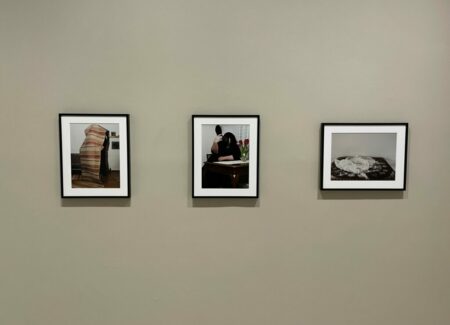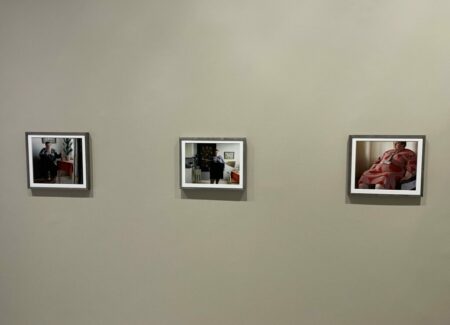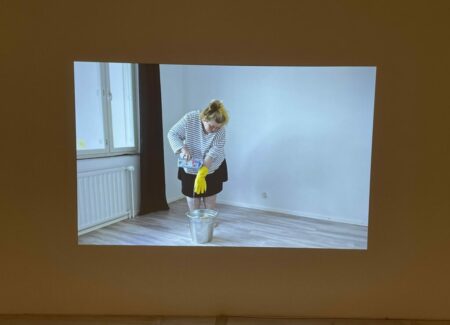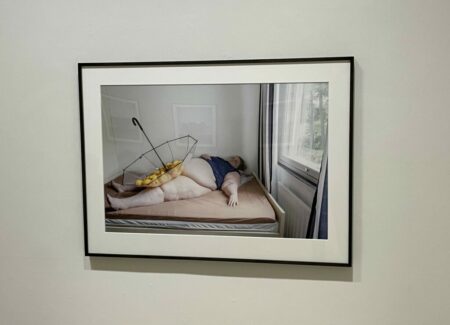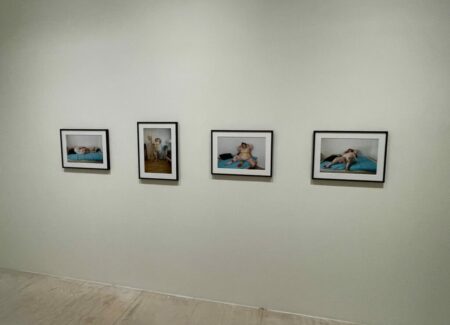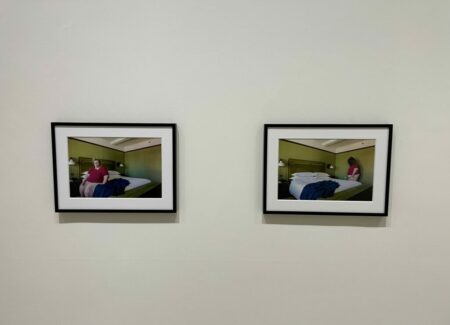JTF (just the facts): A selection of color photographs (framed in dark wood and matted) and short videos, displayed against light green/almond colored walls in a series of four connected rooms on the first floor on the museum. The exhibit was organized by Jody Graf. (Installation shots and video stills below.)
The following works have been included in the show:
- 48 chromogenic prints, 2008, 2009, 2010, 2011, 2012, 2016, 2017, 2018, 2019, 2020, 2021, 2022
- 13 videos (color, sound), 2012, 2015, 2016, 2017, 2018, 2020
A catalog of the exhibition has been published by the museum. (Cover shot below.)
Comments/Context: When an artist uses his or her own face and body as the subject for single photographs or larger bodies of work, we inevitably get caught up in the definitional (and linguistic) question of whether such pictures are actually “self-portraits”. In many cases, these photographs are indeed knowing studies of the self, or the roles, stereotypes, and permutations of identity that surround the personas that we actively construct for ourselves. For the artists that work in this way, every self-portrait can be looked at through the prism of a singular personality, with each picture becoming an exploratory version or facet of that complex individual.
But there are plenty of other artists who freely use their bodies to make photographs, but who never think of themselves as the person or character being portrayed. Cindy Sherman has often said that her works aren’t self-portraits (and haven’t ever been), and many other photographers who have used their bodies as sculptural raw material are similarly frustrated and perplexed when we try to graft individual personality onto their otherwise anonymous (or not) formal studies and still lifes.
So when we look at the works of the Finnish photographer Iiu Susiraja, which nearly always feature the artist looking directly at us, straight into the lens and into a deadpan one-on-one dialogue with the viewer, we might assume, or at least be tempted into thinking, that these are indeed self-portraits. The photographs tend to be made in the artist’s own home (or that of her parents), where she wears her own clothes (or not) and interacts with the mundane everyday objects to be found in such domestic environments, all of these details seeming to add up to the conclusion that these pictures are “her” in some way. But the unusual blankness of her stare, which creates a kind of disengaged distance from whatever is taking place, brusquely upends that line of thinking, turning us back to the idea that Susiraja is actively staging her own body in these performances, and creating set pieces (and videos) where her body is just one element in precisely controlled and pre-planned tableaux.
This is Susiraja’s first museum exhibit in the United States, and it has been organized to succinctly summarize her work in both photography and video across roughly the past 15 years. Spread through a series of intimate rooms, and allowed to wander chronologically, the works fall into one largely continuous flow, rather than a step-wise progression of discrete projects or stylistic evolutions, even though some subtle patterns and changes in her approach are reasonably apparent. The result is a show that feels quietly immersive, like we have been invited into one of the rooms of Susiraja’s house to witness a few of her sparsely absurd staged performances.
Most of Susiraja’s photographs capture the the artist (via a self-timed exposure) interacting with one or more objects, and to try to embellish that description into something more complex or conceptually sophisticated would misunderstand Susiraja’s intent. Her pictures document the simple interplay between body and thing, whether that thing is a feather duster, a badminton racquet, a loaf of bread, a toilet plunger, or a half inflated balloon. She smells a rubber boot, hangs a dog bone from a necktie, holds a bird house on her head (with a ping pong ball in her mouth) near a Christmas tree, wears a plastic rain poncho inside (while soaking her feet), puts fish in her rubber gloves, and wears sausages like ankle weights. If all of this sounds ridiculous, it is, in a way that is so banal and unsentimental that we can’t entirely be sure if Susiraja is joking. Each setup is a mild but seemingly mischievous provocation, where a mundane domestic object is placed where it isn’t supposed to be, the artist’s vacant stare almost taunting us to respond with unease or even outrage.
It is at this point that we need to acknowledge that as a matter of fact (not judgment), Susiraja is fat, indeed very likely obese, and that the scale of her body further amplifies some of these playful interactions. And of course, she knows this, and many of her setups use the ample thickness of her body to further her understatedly satirical creations. She hangs folded dress shirts from underneath her breasts (and does the same with a broom stick, and again with rubber gloves), tucks various objects between her thighs, and tries to fit herself into a top hat (like a magician’s bunny), each scene exaggerated or enabled by the size of her body.
For some, including Susiraja herself, her weight will be a non-event, an objective truth about her body that has simply been incorporated into her artworks; for others, her fatness will bring along with it a range of preconceived notions and prejudices, including questions of excess and gluttony, an obsessive relationship with food, and how desire and sexuality take shape inside a larger body like hers. In general, Susiraja’s photographs seem uninterested in making arguments about body positivity, acceptance, or beauty; instead, they seem to acknowledge and understand how those issues may be percolating around and choose to play with the discomforts they represent head on. She stages herself both nude and semi-clothed in classically seductive odalisque poses on couches and beds, fondles her breasts and packaged meats with vaguely provocative intent, smashes a chocolate cupcake on her chest and puts lollipops and a cake in her panties, uses baguettes and sausages as phallic replacements, and has a plastic pony gallop across her thighs and crotch. Later works find her playfully posing on various pieces of exercise equipment and hiding nude behind a huge Valentine’s Day balloon, continuing to test perceived limits and tweak societal norms.
Susiraja’s short videos extend her single frame photographic setups out into mini cinematic scenes a minute or two in length, giving her a little more time to develop ideas that don’t lend themself to being captured as one photographic moment. There is an unlikely, and often subtly transgressive, “action” in each of more than a dozen of these short videos: spitting into an overturned umbrella and then letting it rain down on her; smashing an egg under her chin to make an omelet; cutting the tips off the fingers of a rubber glove and pouring milk inside to create a makeshift udder; taking a vase out of a glass case, licking it all over, and then putting it back; squeezing a banana until it explodes; and stretching a wire hanger over her head and using it to hang herself from a standing hat rack. Each of these scenes is acted out with Susiraja’s signature sense of theatrical dispassion, the tasks executed with contemplative patience, almost with a sense of blank resignation.
As seen here, the strongest and most memorably quirky of Susiraja’s works mix tongue-in-cheek cleverness with an undercurrent of self-deprecating honesty, finding a note of near-comedic discomfort that the artist can then twist a notch or two further. How can we not smile at Susiraja riding a broom stick pony while standing on the elliptical, or making herself into a unicorn with a chocolate ice cream cone smashed on her head? Every one of these pictures (and videos) has been designed to find an edge of deliberate uneasiness, mockingly flipping us off with sausages for fingers. Such calm visual irreverence can be both challenging and disquieting, and Susiraja’s works offer the promise of an ongoing career of quiet provocation.
Collector’s POV: Iiu Susiraja is represented by Nino Mier Gallery (here) and Makasiini Contemporary (here). Her work has little consistent secondary market history, so gallery retail likely remains the best option or those collectors interested in following up.



